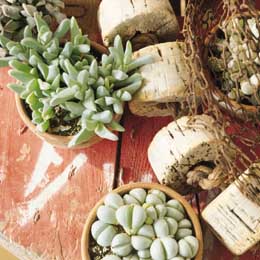 |
Lithops
Name - Commonly known as living stones because they adopt similar features,
in terms of shape, size and colour, to the pebbles found in their natural habitat.
Lithops is taken from the Greek words 'lithos' for stones and 'ops' for like.
Description - They are succulents of 2"-4" (5-10cm) in diameter
and they grow almost completely embedded in the soil, exposing only their "body",
a pair of thick and semi-circular succulent leaves fused together. It grows a
single, daisy-like flowers from its fissure or slit. After flowering and seeding
the body then breaks open a new set of fleshy leaves. Because there is a bewildering
array of colours and patterns, collecting lithops can become a hobby.
Origin
- S. Africa, NamibiaFamily - Mesembryanthemaceae (Aizoaceae)
Varieties - There are about 200 varieties and cultivars.
Care
Tips - Because they come from conditions of extreme heat and drought, they
can tolerate very high temperatures as long there is good ventilation. They need
plenty of sunlight and they have a yearly cycle of growth. Sometimes this is from
autumn through to winter and spring. When they begin to go dormant they require
little or no water. The first sign of growth is when the slit between the leaves
starts to separate to allow a bud to emerge and flower. It is important not to
take out the old leaves while the body is still growing, as it gets its water
and nutrient from them. Only remove when they have shrivelled into thin papery
shells. Use well drained soil and bigger and deeper pots with drain holes to accommodate
their big roots. They are very slow growers and they usually flower, provided
they have the right conditions when they are three to five years old. As they
get older, they increase in size by division and some plants can have as many
as ten bodies but these take many years to grow.

back |
|
|

